#convair f 102 delta dagger
Explore tagged Tumblr posts
Text

The new American tradition... be prepared. Ad for the Convair F-102A Delta Dagger - 1955.
#vintage illustration#vintage advertising#supersonic interceptor#interceptor aircraft#military interceptor#convair f-102#convair f 102#convair#f-102#f 102#delta dagger#convair f-102 delta dagger#convair f 102 delta dagger#f-102 delta dagger#f 102 delta dagger#usaf#u.s. military#u.s. air force#united states air force
3 notes
·
View notes
Text



The oldest F-4 Phantom II in the inventory at the time, belonging to the Michigan Air National Guard, shot down the last F-102 manufactured in its last flight as a QF- drone. (See article for remaining details.)



#f 4 phantom#F-102#delta dagger#mcdonnell douglas aviation#convair#QF drone#air to air#cold war aircraft#cold war era#military aviation#military aircraft#usaf#air national guard
133 notes
·
View notes
Text

Convair jewels
B-58 Hustler
F-102 Delta Dagger
@IL_wheels via X
#b 58 hustler#bomber#f 102 delta dagger#interceptor#convair aviation#aircraft#usaf#aviation#cold war aircraft#military aircraft#military aviation#aviation military pics#aviation military
57 notes
·
View notes
Text

Convair YF-102-CO Delta Dagger Test Aircraft 52-7995, 1954. ➤VIDEO: https://youtu.be/AbapD8n3iZw
➤COLD WAR ERA VIDEOS: https://dronescapes.video/ColdWar
➤HD IMAGE: https://dronescapes.video/f102
#convair#F102#F-102#Delta Dagger#cold war aircraft#cold war era#cold war history#youtube#aircraft#airplane#aviation#dronescapes#documentary#military#aviation history#military history#nuclear weapons
51 notes
·
View notes
Text

Colorized photo of the Convair F-102 Delta Dagger.
source
49 notes
·
View notes
Link
The article, "Convair F-102 Delta Dagger," authored by Friedrich Seiltgen and published on The Armory Life, delves into the history and significance of the Convair F-102 Delta Dagger, a Cold War-era supersonic interceptor. Known as "The Deuce," the F-102 was the first operational all-weather supersonic aircraft used by over 25 Air Defense Command Squadrons of the United States Air Force. It was developed to intercept Soviet bombers with a design focused on guided missiles, excluding guns. Despite a challenging development phase marked by a redesign due to performance issues, the F-102 went on to set a world speed record in 1959. The article also highlights its service in the U.S. Air Force, including deployment in Vietnam, and its limited foreign service with Turkey and Greece. Although eventually superseded by newer models like the F-106 Delta Dart and F-4 Phantom, the F-102 remains a notable aircraft in the history of aerial defense strategy.
#Convair F-102 Delta Dagger#U.S. Air Force#interceptor aircraft#Cold War#supersonic speed#delta wing design#Hughes Falcon missile#General Electric J57 turbojet#Vietnam War#air defense#interception missions#Curtis LeMay#SAGE (Semi-Automatic Ground Environment)#radar-guided missiles#1960s technology.
0 notes
Text

RARE USAF Convair F-106 Delta Dart Fighter Interceptor Patch Cold War Century
RARE USAF Convair F-106 Delta Dart Fighter Interceptor Patch Cold War Century. This patch is an exact copy of the one Convair awarded to its test pilots and USAF pilots early in the F-106 program. The F-106 all-weather delta wing interceptor was developed from the Convair F-102 Delta Dagger. RARE, beautifully detailed 4" Convair F-106 Delta Dart patch. This patch is an exact copy of the one Convair awarded to its test pilots and USAF pilots early in the F-106 program. I have yet to see an original for sale and it would certainly cost you hundreds of dollars if you were to find one. Convair also produced an F-102 version of this patch which is a near mirror copy except for the name obviously and the relatively small differences between the two planes such as the exhaust, intakes, etc. I also have the F-102 version in my eBay store. The F-106 all-weather delta wing interceptor was developed from the Convair F-102 Delta Dagger. Originally designated F-102B, it was redesignated F-106 because it had extensive structural changes and a more powerful engine. The first F-106A flew on December 26, 1956, and deliveries to the Air Force began in July 1959. Production ended in late 1960 after 277 F-106As and 63 F-106Bs had been built. The F-106 used a Hughes MA-1 electronic guidance and fire control system. After takeoff, the MA-1 could be given control of the aircraft to fly it to the proper altitude and attack position where it could then fire the Genie and/or Falcon missiles, break off the attack run and return the aircraft to the vicinity of its base. The pilot would take control back for the landing (USAF Museum Fact Sheet). It was the last of the Century Series fighters unless you count North American's F-107.
19 notes
·
View notes
Text

Convair F-102 Delta Dagger
11 notes
·
View notes
Photo

USAF F-102′s from the 82d Fighter-Interceptor Squadron over South Korea (1970)
#Convair#F-102#Delta Dagger#Jet interceptor#Fighter aircraft#Cold war era aircraft#Military jets#Century series fighters
99 notes
·
View notes
Text
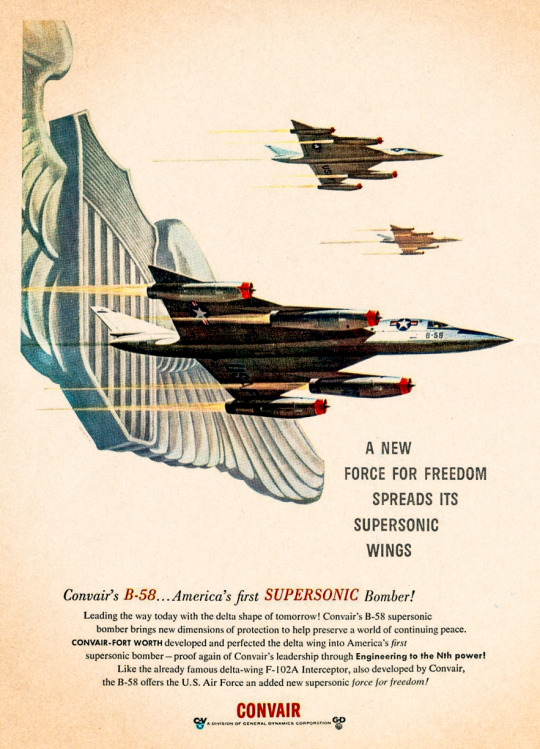
Convair’s B-58... America’s first supersonic bomber - 1957.
#vintage advertising#vintage illustration#convair#convair p5y#convair r3y#convair skate#consolidated vaultee aircraft company#consolidated vaultee#vintage aircraft#military aircraft#jet bombers#delta dagger#f-102#jet fighters#b-58#b-58 hustler#f-102 delta dagger#supersonic bomber#supersonic aircraft#bombers
143 notes
·
View notes
Text
So, do you know what happens when you let an aircraft design bureau known for making bombers, make an interceptor?
You get, from Convair, know for making the B-58 Hustler
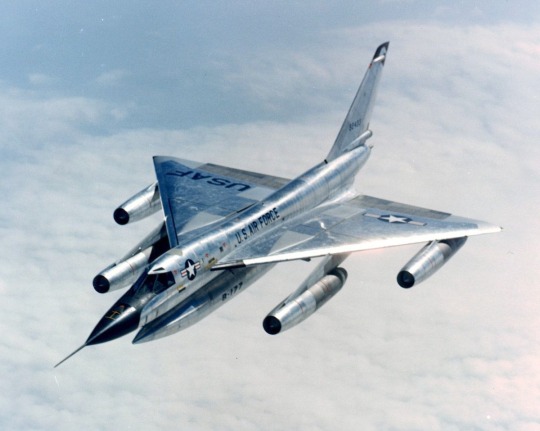
the world’s first supersonic bomber
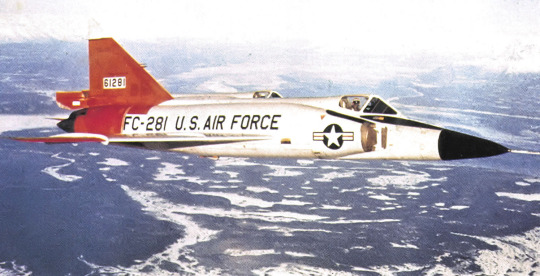
The F-102 Delta Dagger

And the F-106 Delta Dart
And from Tupolev, known from pretty much being THE bomber-maker of the Soviet Union, among them the Tu-22 “Blinder”
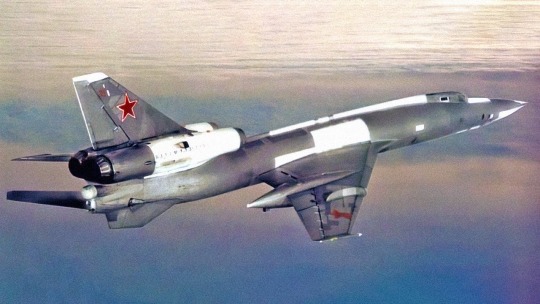
The Soviet Union’s first supersonic bomber, and the only supersonic bomber to be available for export customers, you get

The Tu-128, the world’s heaviest “fighter” aircraft.
Oh, and for the opposite, see what happens when you let Dassault, known for making France’s fighter jets since WW2

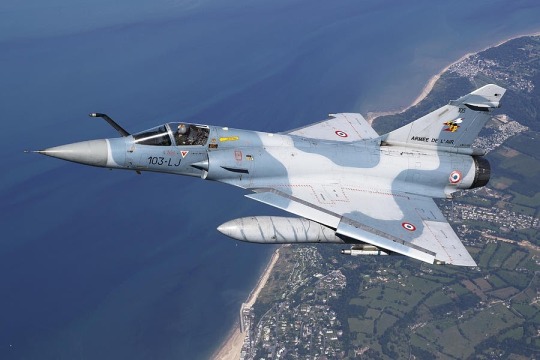
especially supersonic delta wing designs, you get
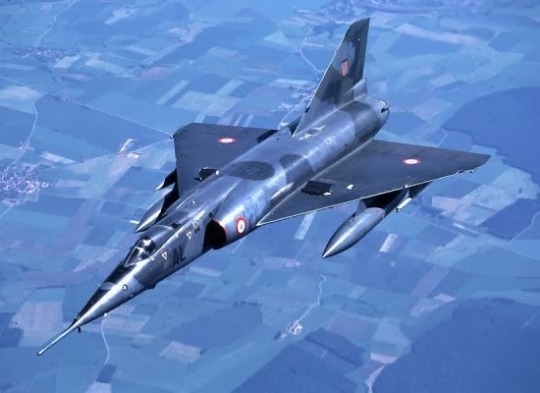
The Mirage IV, the world’s shortest-ranged nuclear bomber.
249 notes
·
View notes
Text

Convair F-102's official designation, "Delta Dagger," was rarely used in everyday conversation; aircraft was almost exclusively referred to as "Deuce." Similarly, TF-102 variant earned nickname "Tub" due to its wider fuselage, designed to accommodate side-by-side twin seating
@CcibChris via X
27 notes
·
View notes
Photo

USAF Convair F-102 Delta Daggers, 1966.
29 notes
·
View notes
Text
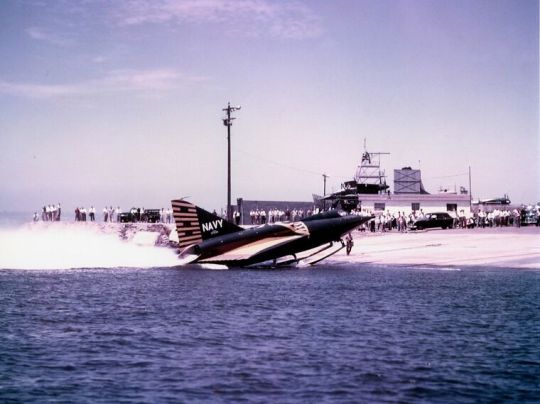
- Convair XF2Y-1 Sea Dart (BuNo 137634) landing on shore. | Photo: US Navy
FLIGHTLINE: 128 - CONVAIR F2Y-1 SEA DART
Designed after WWII, the Sea Dart was the US Navy's first and only supersonic seaplane fighter, though it never saw production.
In the wake of WWII, the US Navy sought a supersonic interceptor aircraft, but doubts about operating jet aircraft, especially supersonic jets, from carriers led to the request for a seaplane interceptor. Convair's design team under Ernest Stout proposed a plane based on the F-102 Delta Dagger, modified with retractable skis.

-Orthograph of the Sea Dart. | Illustration: Convair
In order to reduce the chances of water ingestion, the intakes were moved behind the cockpit, high on the fuselage. The aircraft would sit level in the water, with the wingtips providing floatation for some measure of stability. At 10mph, the skis would extend to an intermediate position, pushing the fuselage out of the water. Between forty-five and fifty-five mph the skis would be fully extended; take off speed would be 145mph. Production aircraft were expected to be fitted with a pair of Westinghouse J46 turbojets, though the prototypes were equipped with J34s instead, as the former were not available. The prototypes were unarmed, but operational F2Ys were to be fitted with four Colt Mk12 20mm cannon and an unspecified number of folding fin aerial rockets; a similar weapons loadout was carried by the F-89 Scorpion and F-94 Starfire.

-Line drawing of the XF2Y-1 prototype with its single ski. | Illustration: blueprints.com
During construction of the XF2Y-1, the contract was altered, eliminating the second prototype and adding 4 service test aircraft (YF2Y) and eight production F2Y models. The prototype was also fitted with a single larger ski compared to the test types. In December 1952 the XF2Y was transported from Convair's San Diego factory to San Diego Bay for testing. On 14 January 1953 it achieved a short flight during taxi testing, with the first official flight occurring on 9 April.

-The XF2Y with a trailer and access ladder. | Photo: US Navy
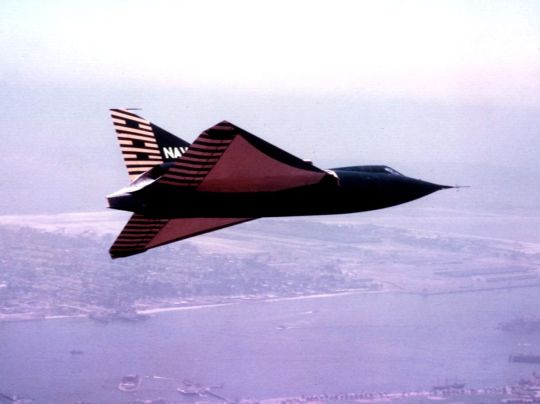
-The XF2Y in flight over San Diego. The yellow markings against the dark blue provided a reference of the aircraft's attitude for engineers. | Photo: US Navy
Flight testing on the XF2Y showed that the plane was (as expected) underpowered with the J34 engines, and was unable to exceed Mach 1. The design, based on the pre-area rulled F-102 fuselage, generated excessive drag, which only exacerbated the issue. In addition, the hydroskis proved to be less effective than hoped, and even with the shock-absorbing oleo legs the aircraft experienced jarring vibrations during takeoffs and landings. Engineers attempted to correct the flaws by refining the ski design, switching to two skis, removing the beaching wheels, and changing the oleo legs, but the vibration issue was never fully solved.
With the cancellation of the second XF2Y, the first two YF2Y test types were fitted with J46s engines and began their test program in 1954. Unfortunately, the J46 proved to also be underpowered, and the Sea Dart was still unable to exceed Mach 1 in level flight. That said, the aircraft did go supersonic on several flights by executing a shallow dive, making it the sole seaplane to break the sound barrier. Tragedy struck on 4 November 1954, when Convair test pilot Charles Richbourg was killed during a demonstration flight. YF2Y-1 BuNo 135762 broke apart in mid-air when the aircraft's structural limitations were exceeded. This accident, combined with lingering issues with the hydroski design and advancing technology allowing supersonic jets to fly from carriers saw the Sea Dart project relegated to experimental status, with the eight production aircraft cancelled and the last two test aircraft completed without engines.
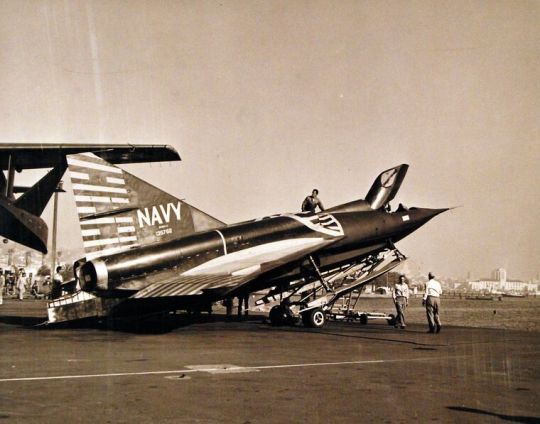
-One of the last photos of Convair pilot Charles Richbourg and the F2Y prior to their ill-fated flight. Photo: US Navy
Flights of the remaining Sea Darts continued, at a reduced tempo, until 1957 after which the aircraft were placed into storage. For this reason, the aircraft were still technically "on the books" in 1962 and were thus redesignated the YF-7A under the Tri-Service scheme, even though they had not flown for some 5 years. One XF2Y prototype and three YF2Y test aircraft survive, on display across the US:
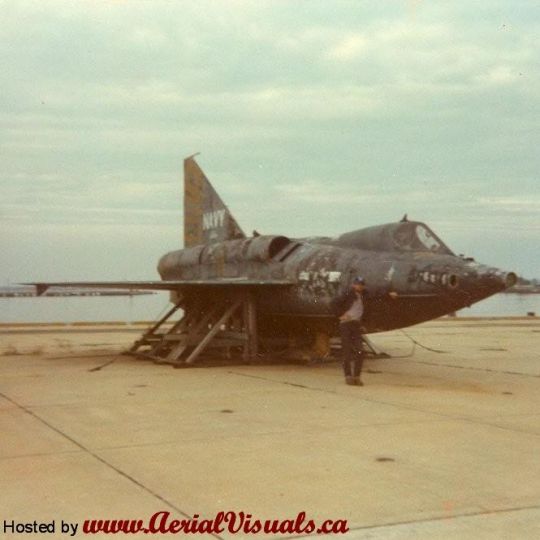
-XF2Y-1 Sea Dart, Bureau Number 137634, is in bad shape due to a mistake with a crane and is awaiting restoration for the Smithsonian Institution in Washington D.C..

-YF2Y-1 Sea Dart, Bureau Number 135763, is on display at the San Diego Air & Space Museum in Balboa Park.
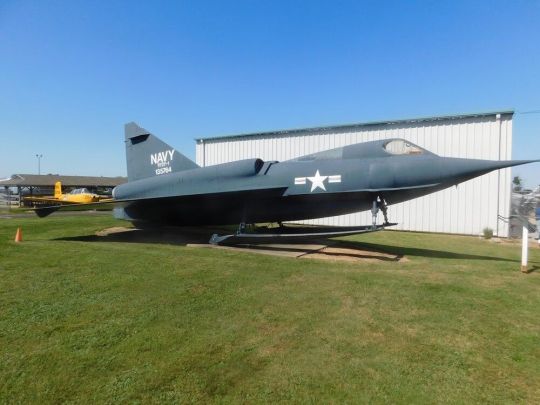
-YF2Y-1 Sea Dart, Bureau Number 135764, is on display at the Wings of Freedom Aviation Museum at NAS Willow Grove, Pennsylvania.

-YF2Y-1 Sea Dart, Bureau Number 135765, is on display at the Florida Air Museum
#aircraft#aviation#avgeek#cold war#airplanes#airplane#cold war history#coldwar#aviation history#navy#us navy#f2y#Convair f2y#Convair sea dart#sea dart#f2y sea dart#xf2y#yf2y#yf7a#yf 7a#Convair#seaplane#sea plane
69 notes
·
View notes
Video
54-1366 1956 Convair TF-102A Delta Dagger USAF Pima Air & Space 25.06.99 by Phil Rawlings Via Flickr: Because the handling characteristics of delta-wing aircraft are very different from conventional aircraft, particularly at take-off and landing it was determined that a dedicated trainer was needed for pilots transitioning to the F-102. Nicknamed “The Tub” for its redesigned bulbous nose the TF-102A allowed pilots to learn the intricacies of high-speed interceptor tactics as well as of the plane’s tricky handling. Each squadron that flew Delta Daggers was assigned two trainers as well. A total of 111 TF-102s were ordered but only 63 were built.
2 notes
·
View notes
Photo

Convair F-102 Delta Dagger
33 notes
·
View notes